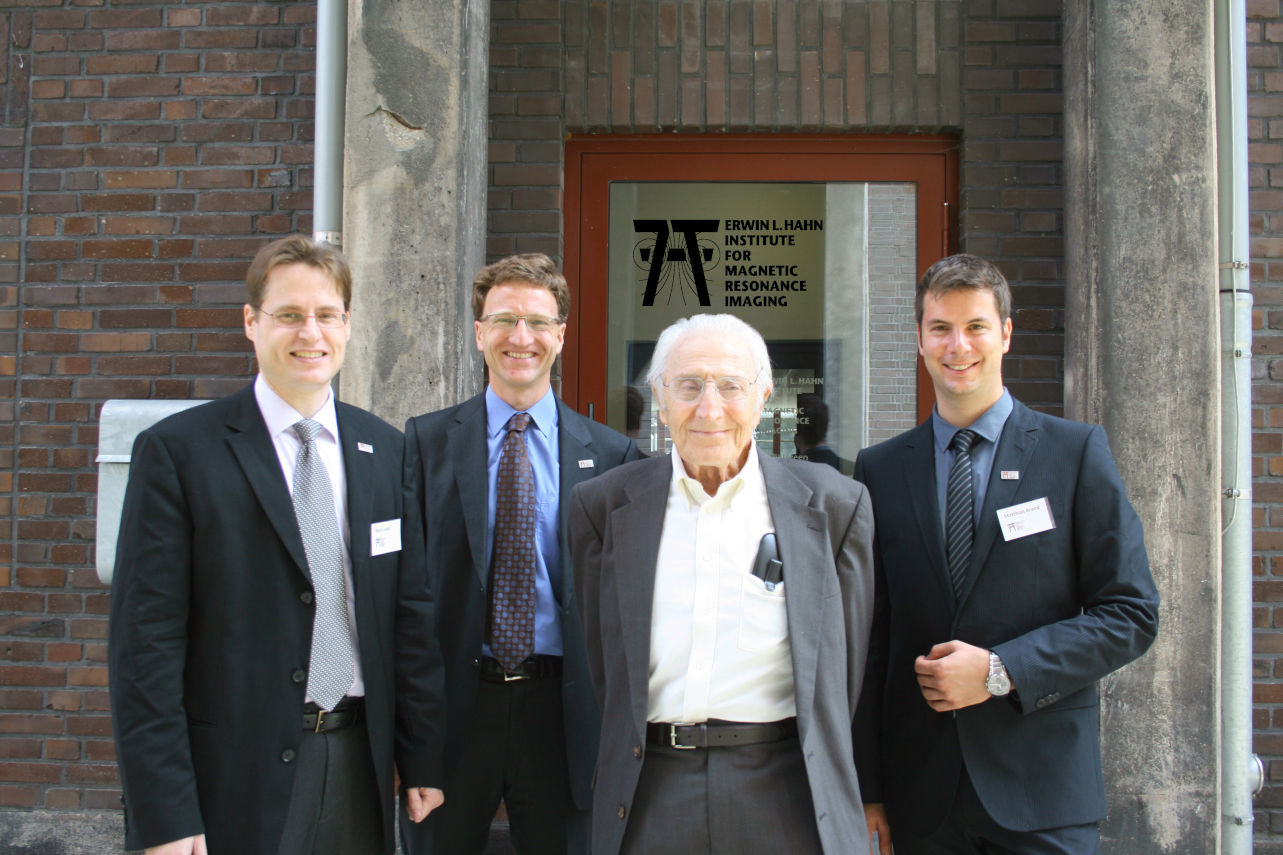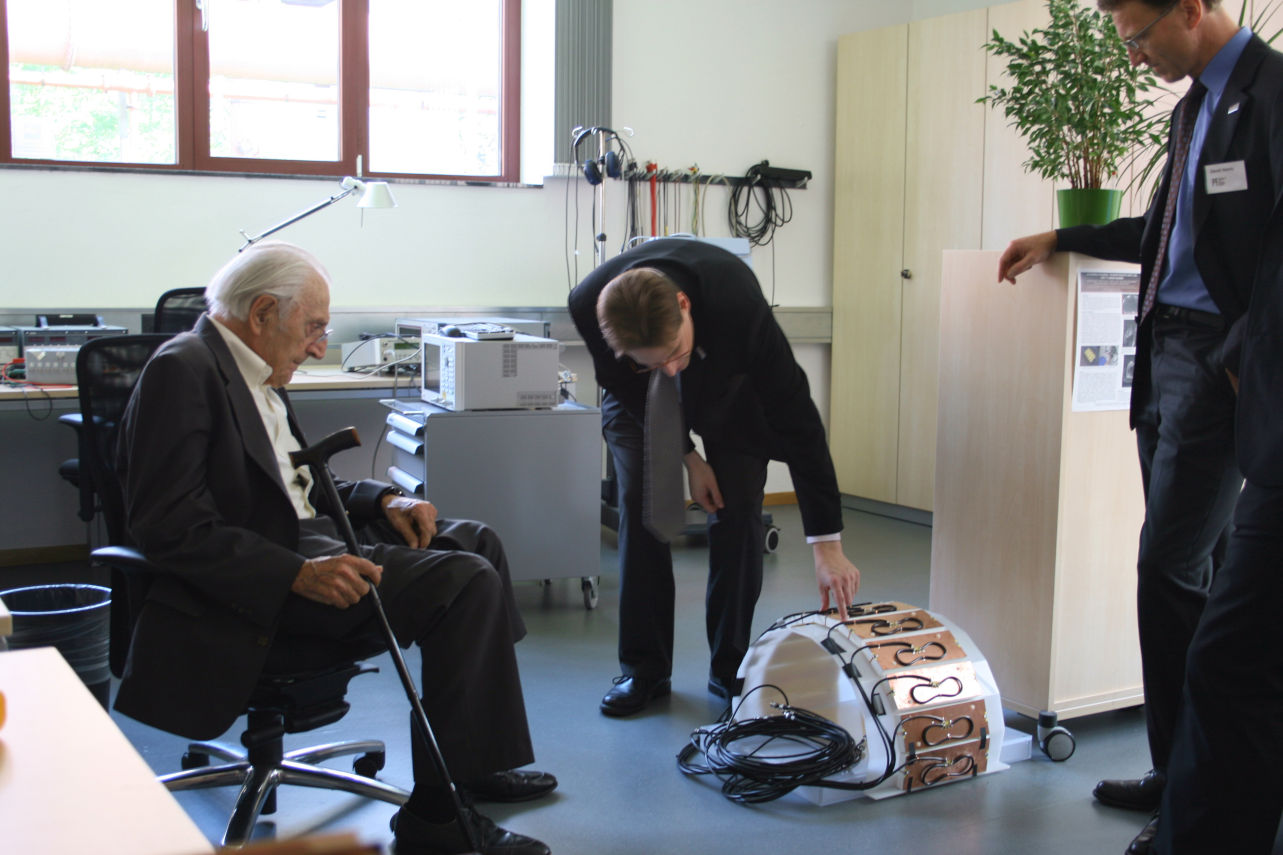Erwin L. Hahn
Who was Erwin L. Hahn?
Erwin Louis Hahn (06/09/1921 – 09/20/2016) was an American physicist and the discoverer of the spin echo, one of the most fundamental methods of signal generation in magnetic resonance imaging. His work laid the foundation for MRI research and revolutionised both science and medical diagnostics. Born in 1921, he was also one of the first scientists to establish the relevance of gradient echoes and the discoverer of pulse sequences. Despite the immense importance of his research, most people have never heard the name Erwin L. Hahn: Many times he was not credited for his huge influence on science. In a 2016 interview, he said: "Spectroscopists spent a lot of time publicising what they did, and I did not. This didn't put me in the limelight. It put them in the limelight. That's what happened." 1
1 Feinberg, David A. (2016): The transformative genius of Erwin Hahn, In: Magnetic Resonance in Medicine, S. 9.

After earning a bachelor's degree in chemistry, Hahn taught radar and sonar engineering in the US Navy during World War II. He was also an assistant to betatron developer Donald William Kerst at the University of Illinois, where he earned a master's degree in 1946. In 1949, he earned a PhD in nuclear magnetic resonance. His thesis was entitled Nutation of the nuclear magnetic moment and associated effects in spin ensembles.
In the same year, Erwin Hahn discovered the spin echo by chance. He was busy shortening radio frequency pulse sequences when he saw something unusual on his pulse generator. Hahn initially thought it was a fault in the system - an "irritating glitch". But when it occurred again, he realised he was on to something new. At that time, Erwin Hahn could not have imagined how important his discovery would be.
During his scientific career, Hahn made many numerous contributions to magnetic resonance imaging and received several important awards during his lifetime, such as honorary doctorates from the Universities of Stuttgart and Oxford, memberships of the American and Russian Academies of Science and the British Royal Society. However, Erwin L. Hahn never received the Nobel Prize.
Besides his interest in physics, he had a great passion for music and especially for the physics of music. Hahn played the violin in a chamber music ensemble and taught the physics of music to students. He was considered headstrong and egocentric but also entertaining, charming and sociable. Until his death in 2016, Erwin Hahn always harboured the urge to learn something new; and still published many important publications well into old age.
On the occasion of the Institute's tenth anniversary, Prof. Lawrence Wald of Harvard University gave a memorial address to Prof. Erwin L. Hahn at the Erwin L. Hahn Lecture & Workshop. The physicist and namesake of the Institute had passed away just a few weeks earlier at the age of 95. Prof. Lawrence Wald was the last PhD student supervised by Prof. Hahn during his long career.
More information on Erwin L. Hahn's life can be found in a memoir article of Alexander Pines and Dmitry Budker.

Awards
- 1971: Oliver E. Buckley Condensed Matter Prize
- 1971: Prize of the International Society for Magnetic Resonance (ISMAR)
- 1971: Fellow der American Academy of Arts and Sciences
- 1972: Member of the National Academy of Sciences of the United States of America
- 1983: Wolf-Prize
- 1992: External member of the Académie des sciences
- 1993: Comstock-Prize for Physics
- 2000: External member of the Royal Society
- 2001: Honorary Doctorate of the University of Stuttgart
- 2009: Honorary Doctorate of the University of Oxford
- 2016: Gold medal of the International Society for Magnetic Resonance in Medicine (ISMRM)
Selected Publications
- Hahn, EL (1949): An accurate Nuclear Magnetic Resonance Method for measuring Spin-Lattice Relaxation Times. In: Physical Review. Vol. 76 (1), S. 145-146.
- Hahn, EL (1950): Spin Echoes. In: Physical Review. Vol. 80 (4), S.580-594
- Hahn, EL and Bartley, SH (1954): The Apparent Orientation of a luminous Figure in Darkness. In: The American Journal of Psychology 1954, Vol. 67 (3). S. 500-508.
- Das, TP and Hahn, EL (1958): Nuclear quadrupole resonance spectroscopy. New York: Acad. Press
- Hahn, EL and McCall, SL (1967: Self-Induced Transparency by Pulsed Coherent Light. In: Physical Review Letters. Band 18, 1967, S. 908–911.
- Diels, JC and Hahn, EL (1976): Pulse propagation stability in absorbing and amplifying media. In: IEEE journal of quantum electronics 1976, Vol. 12 (7), S. 411-416.
- Hahn, EL (1978): Pulsed nuclear magnetic resonance in solids. A survey. In: Faraday symposia of the Chemical Society 1978, Vol. 13, S. 7-18.
- Brewer, RG and Hahn, EL (1984): Atomic Memory. In: Scientific American, 1984. Vol. 251 (6), S. 50-57.
- Sleator T and Hahn, EL and Hilbert, C and Clarke, J (1985): Nuclear-spin noise. In: Physical review letters, 1985, Vol. 55 (17), S. 1742-1745.
- Hilbert, C and Clarke, J and Sleator T and Hahn, EL (1985): Nuclear quadrupole resonance detected at 30 MHz with a dc superconducting quantum. In: Applied physics letters 1985, Vol. 47 (6), S. 637-639.
- Sleator T and Hahn, EL and Hilbert C and Clarke J (1987): Nuclear-spin noise and spontaneous emission. In: Physical review. B, Condensed matter. 1987, Vol. 36 (4), S. 1959-1980.
- Hahn, EL and Harris, RA and Grayce, CJ (1988): The nuclear-quadrupole-induced dipole moment of HD. In: Chemical physics letters 1988, Vol. 147 (5), S. 443-451.
- Fan, NQ and Heaney, MB and Clarke, J and Newitt, D and Wald, LL and Hahn, EL and Bielecki, A and Pines, A (1989): Nuclear magnetic resonance with DC SQUID preamplifiers. In: IEEE Transactions on Magnetics, 1989, Vol. 25 (2), S. 1193-1199.
- Hahn, EL (1990): NMR imaging: recent developments and future prospects – NMR and MRI in retrospect. In: Philosophical transactions of the Royal Society of London. Series A: Physical sciences and engineering, 1990. Vol. 333 (1632), S. 403-411.
- Hahn, EL (1990): NMR and MRI in Retrospect [and Discussion]. In: Philosophical transactions of the Royal Society of London. Series A: Physical sciences and engineering, 1990. Vol. 333 (1632), S. 403-411.
- Hahn, EL and Newitt, DC (1994): Detection of two-quantum nuclear coherence by nuclear-quadrupole-induced electric polarization. In: Journal of magnetic resonance. Series A, 1994, Vol. 106 (1). S. 140-143.
- Hahn, EL (1995): Analysis of Coherent Raman Beats from a Four-Level Electron-Nuclear-Spin-coupled System. In: Journal of magnetic resonance. Series A, 1995, Vol. 116 (2), S. 230-236.
- Hahn, EL (1997): Concepts of NMR in quantum optics. In: Concepts in Magnetic Resonance 1997. Vol. 9 (2), S. 69-81.
- Hahn, EL (1997): Radiation damping of an inhomogeneously broadened spin ensemble. In: Concepts in Magnetic Resonance 1007, Vol. 9 (2). S. 65-67.
- Augustine, MP and Hahn, EL (1998): Three-component Spin Echoes. In: The journal of physical chemistry. B, 1998, Vol. 102 (42), S. 8229-8238.
- Hahn, EL and Kresin, VV and Reynolds, JH (1999): Walter David Knight: an appreciation. In: Philosophical magazine. B. Physics of condensed matter. Electronic, optical and magnetic properties, 1999, Vol. 79 (9), p. 1225.
- Augustine, MP and Bush, SD and Hahn, EL (2000): Noise triggering of radiation damping from the inverted state. In: Chemical physics letters, 2000, Vol. 322 (1), S. 111-118.
- Augustine, MP, Hahn, EL (2001): Radiation damping with inhomogeneous broadening: Limitations of the single Bloch vector model. In: Concepts in magnetic resonance, 2001. Vol. 13 (1), S. 1-7.
- McDermott, R and Trabesinger, AH and Mück, M and Hahn, EL and Pines, A and Clarke, J (2002): Liquid-State NMR and Scalar Couplings in Microtesla Magnetic Fields. In: Science (American Assosiaction for the Advancement of Science), 2002, Vol. 295 (5563), S. 2247-2249
- Clarke, J and Hahn, EL and Lee, SK (2006): Static nuclear spin polarization induced in a liquid by a rotating magnetic field. In: Physical review letters, 2006 Vol. 95 (25), S. 257601/1-257601/4.